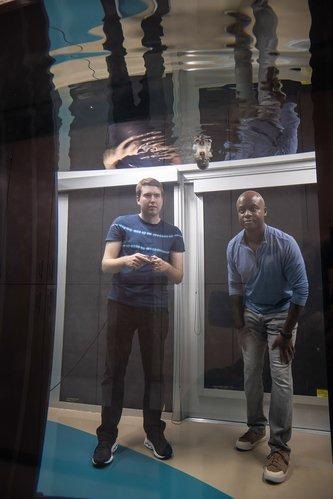Successfully navigating the oceans has allowed humankind to explore the world and make countless new discoveries that have contributed to the advancement of civilization. However, pinpointing exact locations and wading through ever-shifting tides and currents has always been a challenge.
 Image Credit: Caltech, California Institute of Technology
Image Credit: Caltech, California Institute of Technology
Today, humanity continues to explore the depths of the ocean using robots to dive into unfathomable depths to better understand the planet, its resources, life, and any environmental changes that could be of significance. Now, Engineers at Caltech, Harvard and ETH Zurich are using artificial intelligence (AI) that will enable autonomous drones to navigate the ocean using ocean currents.
One of the challenges when sending drones into the deep sea, particularly in large numbers (swarms), is maintaining a certain level of control over them. It is not as simple as using a joystick or computer interface to control a robot 20,000 feet below the sea surface. Additionally, researchers can not send the relevant data to the machines to aid navigation, so developing ocean-borne drones that can navigate for themselves seems logical.
RL-Based AI Navigation System
Published in the journal Nature Communications, the researcher’s detail how a recently introduced Reinforcement Learning algorithm was applied to discover time-efficient navigation policies to guide a fixed-speed swimmer through unsteady two-dimensional flow fields.
The algorithm entails inputting environmental cues into a deep neural network that determines the swimmer’s actions, and deploying Remember and Forget Experience Replay.
John O. Dabiri, the Centennial Professor of Aeronautics and Mechanical Engineering at Caltech and Corresponding Author of the Study
The researchers ran a series of simulated navigation problems as a testing environment for the RL-based AI navigation system when developing the algorithm. By simulating simple and complex ocean flows, vortex systems and turbulence, the objective was to create a fully autonomous system that could guide a drone through the ocean.
To fine-tune the system, the team only supplied the algorithm with information on water currents relative to its immediate location. Quickly, the AI was able to use this information to then guide itself towards the target. This system could, in effect, be translated from the simulation into a physical robot fitted with a gyroscope and accelerometer to achieve a similar result.
Not only will the robot be learning, but we'll be learning about ocean currents and how to navigate through them.
Peter Gunnarson, Graduate Student at Caltech and Lead Author of the Study
Ocean Exploration and Beyond
Much to their surprise, the team soon realized that their reinforcement learning algorithm could grasp navigation strategies that could theoretically be just as effective, if not more so, than those that real fish use when navigating the depths of the ocean.
A bio-inspired approach of sensing the local vorticity provided a modest increase in navigation success over a position-only approach, but surprisingly the key to success was discovered to lie in sensing the velocity field, which more directly determined the future position of the swimmer.
Peter Gunnarson, Graduate Student at Caltech and Lead Author of the Study
Combining AI with fully mechanical robotics could produce a drone capable of making its own decisions when it comes to navigation and how to charter a course most efficiently. The team also believes that this system could aid the exploration of oceans on other planets as the robotics-led exploration of outer space continues.
For now, there is still work to be done as the technology is in the early stages of development as the team continues to develop more sophisticated models and simulations to improve the RL-based system when faced with more complex real-world scenarios.
References and Further Reading
California Institute of Technology. (2021) Engineers Teach AI to Navigate Ocean with Minimal Energy. [online] Available at: https://www.caltech.edu/about/news/scientists-teach-ai-to-navigate-ocean-with-minimal-energy
Gunnarson, P., Mandralis, I., et al., (2021) Learning efficient navigation in vortical flow fields. Nature Communications, [online] 12(1). Available at: https://doi.org/10.1038/s41467-021-27015-y
Disclaimer: The views expressed here are those of the author expressed in their private capacity and do not necessarily represent the views of AZoM.com Limited T/A AZoNetwork the owner and operator of this website. This disclaimer forms part of the Terms and conditions of use of this website.